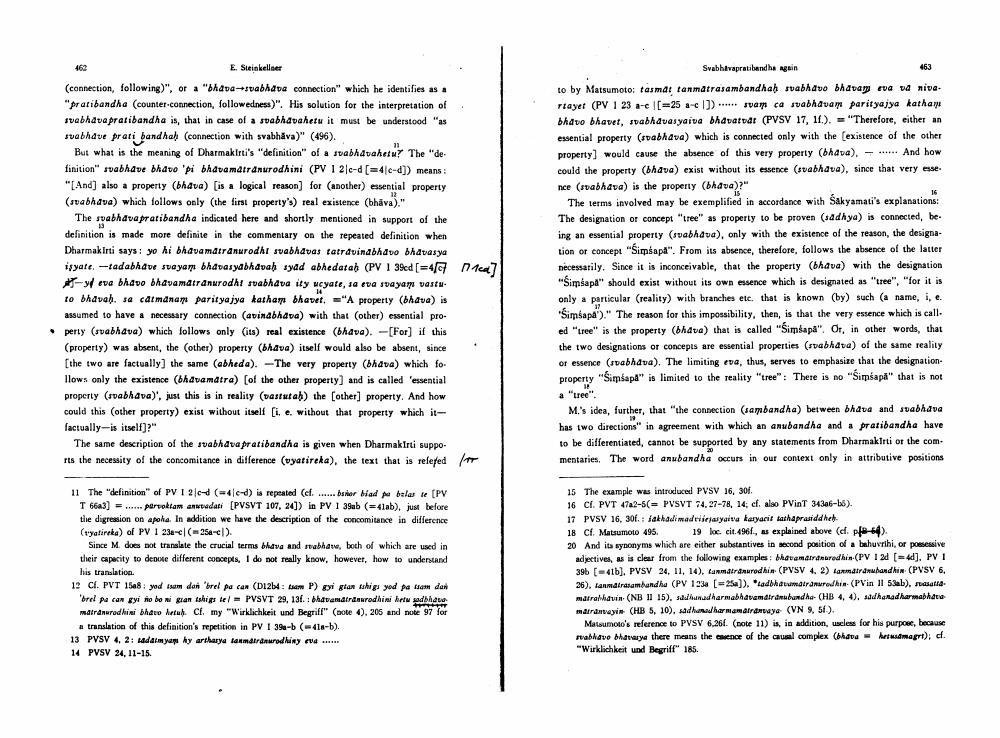Book Title: Svabhavarat Bandha Again Author(s): Ernat Steinkellner Publisher: Ernat Steinkellner View full book textPage 4
________________ 463 E. Steinkeller (connection, following)", or a "bhavanabhapa connection" which he identifies as a "pratibandha (counter-connection, followedness)". His solution for the interpretation of svabhava pratibandha is, that in case of a svabhavahetu it must be understood "as svabhave prati bandhah (connection with svabhava)" (496). But what is the meaning of Dharmakirti's "definition" of a svabhavahetu? The "de. finition" sabhave bhavo 'pi bhavamatranurodhini (PV 1 21c-d (= 41c-d]) means: "[And] also a property (bhava) [is a logical reason) for another) essential property (svabhava) which follows only the first property's) real existence (bhava)." The svabhava praribandha indicated here and shortly mentioned in support of the delinition is made more definite in the commentary on the repeated definition when Dharmakirti says: yo ni bhavamatranurodhl svabhavas tatravinabidvo bidvasya isyate-tadabhave svayam bhavasyabhavah sydd abhedatab (PV 139d (= Weva bhavo bhavamatranurodhi sabhavaity weyate, 14 eva svaya vastu to bhavah. sa carmanam parityajya katham bhavet. ="A property (bhava) is assumed to have a necessary connection (avinabhava) with that other) essential properly (svabhava) which follows only (its) real existence (bhava). -[For] if this (property) was absent, the other property (bhava) itself would also be absent, since [the two are factually the same (abheda). -The very property (bhava) which fo. llows only the existence (bhavamatra) (of the other property) and is called 'essential property (svabhava)', just this is in reality (vastutah) the (other) property. And how could this (other property) exist without itself [i. e, without that property which itfactually-is itself]?" The same description of the svabhava pratibandha is given when Dharmak Irti suppo rts the necessity of the concomitance in difference (wyatireka), the text that is releed n1uu Svabhivapratibandhe Again to by Matsumoto; tasmat tanmatrasambandhah sabhavo bhavaneva va niva. riayet (PV 1 23 -c [=25 a-c 1]) ..... suam ca suabhavam parityajya katha bhavo bhavet, svabhavas yaiva bhavarude (PVSV 17, 11.). "Therefore, either an essential property (svabhava) which is connected only with the existence of the other property] would cause the absence of this very property (bhava). - .. And how could the property (bhava) exist without its essence (svabhava), since that very esse nce (svabhava) is the property (bhava)?" The terms involved may be exemplified in accordance with Sakyamadi's explanations: The designation or concept "tree" as property to be proven (sadhya) is connected, be. ing an essential property (svabhava), only with the existence of the reason, the designa. tion or concept "Simsapa". From its absence, therefore, follows the absence of the latter necessarily. Since it is inconceivable, that the property (bhava) with the designation Simsapl" should exist without its own essence which is designated as "tree", "for it is only a particular (reality) with branches etc. that is known (by) such a name, i, e. Simsapa')." The reason for this impossibility, then, is that the very essence which is call. ed "tree" is the property (bhava) that is called "Simsapa". Or, in other words, that the two designations or concepts are essential properties (svabhava) of the same reality or essence (svabhava). The limiting eva, thus, serves to emphasize that the designationproperty "Simšapa" is limited to the reality "tree": There is no "Simšapā" that is not a "tree". M.'s idea, further, that the connection (sambandha) between bhdua and swabhava has two directions in agreement with which an anubandha and a pratibandha have to be differentiated, cannot be supported by any statements from Dharmakirli or the com mentaries. The word anubandha occurs in our context only in attributive positions / 11 The "definition of PV I 21-d (=4c-d) is repeated (cf..... brrer Mad balas te (PV T 6643] = ...... parrokiam anwedati (PVSVT 107, 24]) in PV 1 39ab (=41ab), just before the digression on apola. In addition we have the description of the concomitance in difference (wyatirka) of PV 1 23e-c|(25a-c). Since M does not translate the crucial terms bhava and rabhawe, both of which are used in their capacity to denote different concepts, I do not really know, however, how to understand his translation 12 Cl. PVT 1508 yod som den brel pa cak (D12b4:am P) yi gian thig god pa tam dan brel pa con gyi modo mi gran ishiga te/ - PVSVT 29, 136. : bhavandir nurodhini hatuadhamu matranurodhimi bharo Artur cf. my "Wirklichkeit und Begriff" (note 4). 205 and note 97 for a translation of this definition's repetition in PV I 39-b (-418-b). 13 PVSV 4, 2. madamyum ky artharya lanmdir rodiny v ...... 14 PVSV 24,11-15. 15 The example was introduced PVSV 16, 301 16 Cl. PVT 4722-5(= PVSVT 74.27-78, 14; cf. also PVinT 34306-16). 17 PVSV 16, 3011 lakhadi madriejasyaiva karyani tathaprasiddhed. 18 Cf. Matsumoto 495 1 9 loc. cit.4961, as explained above (dl. pf ). 20 And it synonyms which are either substantives in second position of a bahuerthi, or possessive adjectives, as is clear from the following examples: blauemadurodhin (PV 12d (= 4d). PV 1 395 (-41b). PVSV 24, 11, 14), Lanmadawrodhim (PVSV 4. 2) Landtrawhandhin (PVSV 6. 26), Lanmarasambandhu (PV 1930 [=25a]), tadbhatumdirnurodhin (PV in Il 58ab), studsatta Aidiraldvin (NB II 15), shunadharnabhavamdir amubandho- (HB4, 4). Sadhanadharmabhara maranayi (HB 5, 10), sadhundharmawdiranya (VN 9, 51.). Matsumoto's reference to PVSV 6,261. (note 11) is, in addition, useless for his purpose, because rabhave bhatarya there means the wence of the causal complex (hava - herundmagt), d. "Wirklichkeit und Begriff" 185.Page Navigation
1 2 3 4 5 6 7 8 9 10 11
